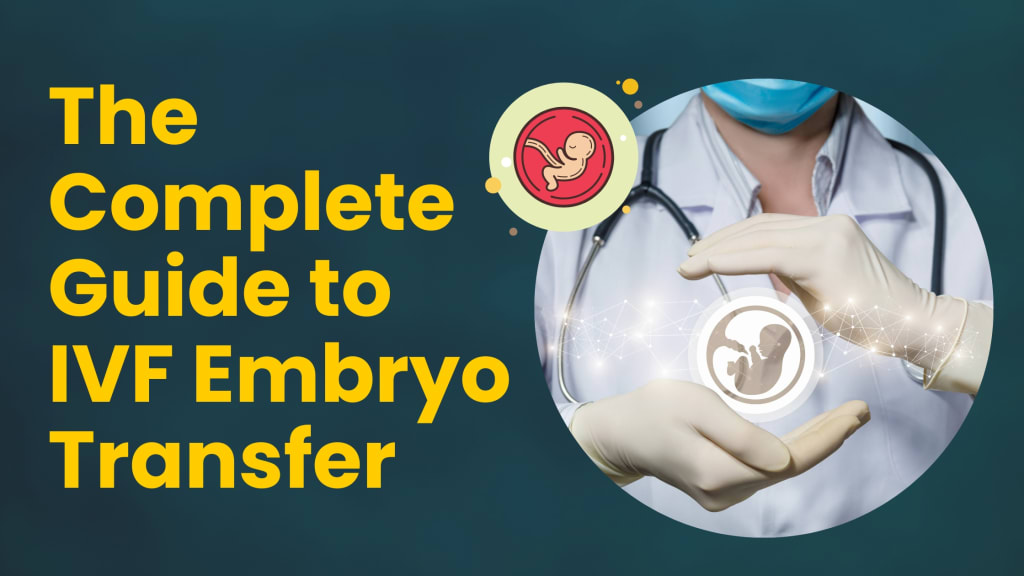The Complete Guide to IVF Embryo Transfer
IVF Embryo Transfer

Introduction:
In Vitro Fertilization (IVF) is a process that involves fertilizing eggs outside the body in a laboratory setting. This assisted reproductive technology (ART) can be used for couples who have difficulty conceiving naturally and for people with certain medical conditions.
IVF is a complex and multi-step process that involves egg retrieval, fertilization, and the transfer of fertilized eggs, called embryos, back into the uterus.
The purpose of this guide is to provide a detailed overview of the IVF embryo transfer process and what to expect before, during, and after the process.
An explanation of IVF and why it may be needed:
IVF is a type of assisted reproductive technology that helps couples conceive when traditional methods of fertilization have failed. It is usually recommended for couples who have been trying to conceive without success for at least a year, or for couples who have certain medical conditions that make it difficult to conceive naturally.
Some common reasons for needing IVF are:
- Infertility caused by obstructed or damaged fallopian tubes
- Infertility caused by a male factor, such as a low sperm count or poor sperm quality
- Endometriosis is a condition in which uterine tissue grows outside of the uterus.
- Polycystic ovary syndrome and other ovulation disorders (PCOS).
- Genetic disorders or chromosomal abnormalities
- Uterine or cervical problems
- Previous surgeries or treatments that affected fertility
- Advanced maternal age
- Couples of the same gender or single people who wish to have children
Preparing for Embryo Transfer:
Preparing for an IVF embryo transfer involves several steps taken to ensure the best chance of success. Some important steps in preparation for embryo transfer are:
Pelvic exam and ultrasound: Before the transfer, the woman will have a pelvic exam to check the position of her uterus and make sure there are no abnormalities. Ultrasound is performed to determine the thickness of the endometrial lining, which should be at least 8 mm thick for optimal implantation of embryos.
Endometrial lining preparation: The endometrial lining is the tissue that lines the uterus and provides a supportive environment for the developing embryo. In the days leading up to the transfer, the woman may be given hormones to help thicken the lining and prepare it for implantation.
Choosing the number of embryos to transfer: The number of embryos to be transferred back into the uterus depends on other factors such as the woman's age and her fertility history. In general, younger women can transfer more embryos, while older women can transfer fewer embryos to reduce the risk of multiple pregnancies.
Medication: Before the transfer, medication may be given to relax the woman and prepare the uterus for the transfer. These medications may include antibiotics, anti-inflammatory drugs, and hormones.
Recovery and follow-up care:
After the embryo transfer procedure, the woman should take it easy and follow specific instructions for self-care in the days following the transfer. Some key steps in recovery and follow-up care are:
Rest after the procedure: After the procedure, the woman needs to rest for a short time, usually an hour. It is recommended to avoid strenuous activities such as heavy lifting or vigorous exercise for the next 24 hours.
Self-care instructions: The woman may be given specific instructions for self-care following the transfer, such as avoiding intercourse or using certain medications. It is important to follow these instructions closely to ensure the best chance of success.
Pregnancy test: A pregnancy test is usually done two weeks after the transfer. This test will determine if the transfer was successful and if the woman is pregnant.
Referral to an Obstetrician: If the pregnancy test is positive, the woman is referred to an Obstetrician for further care. An obstetrician monitors the pregnancy and provides prenatal care throughout the pregnancy.
Considerations and Risks:
While IVF and embryo transfer are successful ways to help couples conceive, there are some considerations and risks to consider. Some of these considerations and risks include:
Multiple pregnancies: One of the major risks of IVF and embryo transfer is the risk of multiple pregnancies such as twins or triplets. This increases the risk of complications for both mother and baby and increases the chances of premature birth.
Ovarian Hyperstimulation Syndrome: Some women may develop a condition called ovarian hyperstimulation syndrome (OHSS), which is a side effect of medications used to stimulate egg production. Symptoms include bloating, nausea, and shortness of breath.
Ectopic Pregnancy: An ectopic pregnancy is a pregnancy that occurs outside the uterus, usually in the fallopian tubes. This is a rare but serious complication that can occur after IVF and embryo transfer and requires immediate medical attention.
Emotional and financial burden: IVF and embryo transfer can be an emotionally and financially taxing experience, especially if the procedure is not successful. Before undergoing the procedure, it is important to consider the emotional and financial burden.
Failure: IVF is not always successful, and many couples require multiple treatment cycles to achieve pregnancy. It is important to have realistic expectations and be aware that the process may not be successful.
Conclusion:
IVF and embryo transfer is a complex and multi-step process that can help couples who are struggling to conceive. It is a great treatment option for infertility, but it is important to be fully aware of the procedure and its associated risks before deciding to proceed.
- The IVF process begins with a thorough evaluation to determine the cause of infertility, followed by a pelvic exam, ultrasound, and medication to implant the uterus. The embryo transfer process is usually quick and painless but is followed by recovery and follow-up care.
- The success rate of IVF and embryo transfer varies depending on factors such as the woman's age and the cause of infertility, but it is the most effective way to help couples conceive. However, it's important to be realistic about your chances of success and be prepared for the emotional and financial burden of implementation.
About the Creator
Enjoyed the story? Support the Creator.
Subscribe for free to receive all their stories in your feed. You could also pledge your support or give them a one-off tip, letting them know you appreciate their work.





Comments
There are no comments for this story
Be the first to respond and start the conversation.